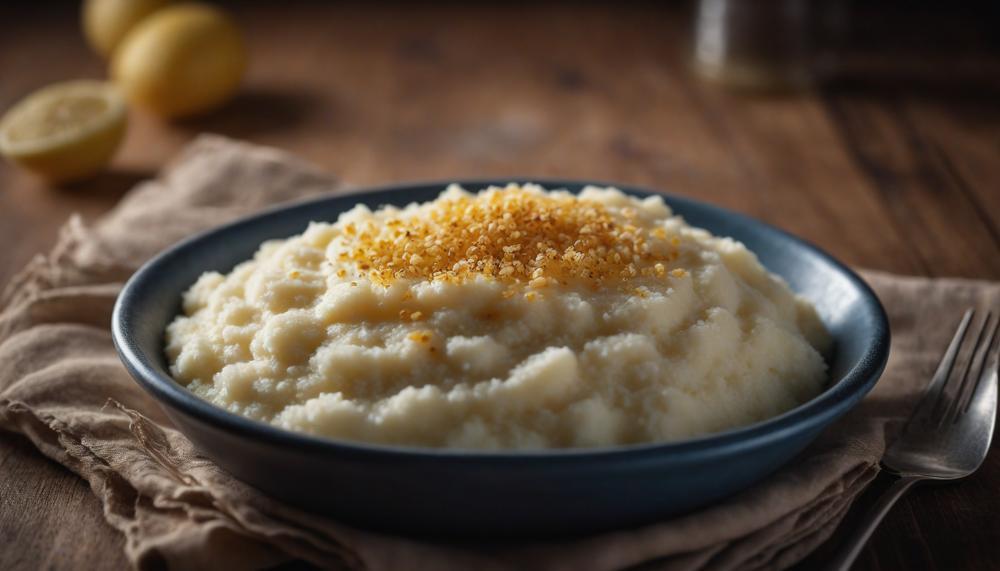Ever wondered if you can freeze those delicious, creamy grits you made for breakfast? The answer is a resounding yes. Freezing cooked grits is a fantastic way to preserve their flavor and texture, ensuring you always have a hearty meal ready when you need it. Here’s what you need to know:
- Store in Proper Containers: Use freezer bags or airtight containers to maintain freshness.
- Portion Wisely: Divide the grits into portions before freezing. Use large containers for bulk storage or ice cube trays for smaller servings.
- Allow for Expansion: Leave some space at the top of the container to accommodate expansion during freezing.
- Shelf Life: Cooked grits can last up to 3 to 4 months in the freezer when stored correctly.
- Enhance with Add-Ins: Consider adding ingredients like sausage, bacon, cheese, or peppers before reheating to elevate the flavor.
- Thawing Method: Thaw your grits gradually in cold water or under running cold tap water to retain their consistency.
- Avoid Refreezing: Refreezing cooked grits can compromise their quality, so it’s best to avoid it.
- Cheese Grits: Freezing cheese grits is also doable—just make sure they’re stored in airtight containers to prevent moisture-related spoilage.
By following these tips, you can enjoy your favorite comfort food anytime without the hassle of cooking from scratch. Keep reading to discover detailed steps and pro tips for freezing, thawing, and reheating your grits like a pro.
Contents
Does Cooked Grits Freeze Well?
Yes, cooked grits freeze well, preserving their texture and taste for future enjoyment.
Key Steps for Freezing Cooked Grits

Portioning:
- Divide cooked grits into individual or family-sized portions. This makes thawing more convenient and reduces waste.
- Use ice cube trays for small portions; once frozen, transfer cubes to a freezer bag.
Storage:
- Place the portions in airtight containers or heavy-duty freezer bags.
- Ensure containers are sealed properly to prevent freezer burn and maintain freshness.
- Leave a small space at the top of the container to allow for expansion.
Duration:
- Cooked grits can last in the freezer for up to 3 to 4 months. Beyond this, the quality may start to decline.
Thawing and Reheating:
- Thaw cooked grits slowly by placing them in the refrigerator overnight or using cold water.
- Reheat gently on the stove or in the microwave, stirring occasionally to ensure even heating.
Enhancing Flavor:
- Before reheating, consider adding ingredients such as cheese, sausage, bacon, or peppers to enhance the flavor of the grits.
- Adding these ingredients post-freezing ensures a fresher taste and better texture.
Refreezing:
- It is not recommended to refreeze cooked grits after thawing, as this can negatively impact their texture and quality.
What Are The Benefits Of Freezing Cooked Grits?
Freezing cooked grits offers numerous benefits that make it a practical choice for anyone looking to save time and reduce food waste. Here’s a detailed look at the advantages:
Convenient Storage:
Freezing grits in small portions allows for flexible meal planning. Whether you use ice cube trays or freezer bags, this method makes it easy to defrost only the amount you need.
| Method | Details | Duration |
| Ice Cube Trays | Portion out individual servings for easy use. | 3-4 months |
| Freezer Bags | Store larger portions, flatten for space-saving. | 3-4 months |
Extended Shelf Life:
By freezing, you can extend the shelf life of cooked grits to about 3 to 4 months, preventing spoilage and reducing waste. This is particularly useful if you’ve made a large batch or have leftovers.
Enhanced Meal Prep
Freezing grits enables you to prepare meals ahead of time. On busy days, you can quickly reheat the frozen grits and add ingredients like sausage, bacon, cheese, or peppers to create a hearty meal without the hassle of cooking from scratch.
Quality Preservation
Proper freezing techniques help maintain the texture and flavor of grits. Using airtight containers or bags prevents ice crystals from forming, which can otherwise make the grits chewy when thawed.
Easy Thawing
Thawing frozen grits is straightforward. You can use cold water or gradually increase the temperature, ensuring that the texture remains smooth. This flexibility in thawing methods makes it easy to integrate frozen grits into various recipes.
Avoids Refreezing Issues
Freezing cooked grits in portions avoids the need for refreezing, which can compromise their quality. This method ensures that you only thaw what you need, keeping the rest in optimal condition.
Versatility in Use
Frozen grits can be reheated with different ingredients, allowing you to customize each meal according to your taste preferences. This versatility makes it a great option for those who like to experiment with flavors and textures.
How To Freeze Cooked Grits
Freezing cooked grits can be a simple process if done correctly. Here are the detailed steps to ensure your grits maintain their quality and taste:
- Cool the Grits: Allow the cooked grits to cool to room temperature. This step is crucial to prevent condensation, which can lead to ice crystals forming in the freezer.
- Portion the Grits: Divide the grits into individual or family-sized portions. Use ice cube trays for small servings or larger containers for bulk amounts.
- Choose Suitable Containers: Place the grits into airtight containers or heavy-duty freezer bags. Ensure the containers are freezer-safe to avoid cracking or breaking.
- Leave Space for Expansion: When using containers, leave some space at the top (about an inch) to allow the grits to expand as they freeze.
- Seal the Containers: Seal the containers tightly to prevent air from entering. If using freezer bags, squeeze out as much air as possible before sealing.
- Label the Containers: Write the date and contents on each container or bag. This helps in tracking the storage time and ensures you use the oldest batches first.
- Freeze Quickly: Place the grits in the coldest part of the freezer. A quick freeze helps in maintaining the texture and flavor of the grits.
- Storage Duration: For the best quality, use the frozen grits within three months.
- Thawing Grits: Thaw the grits by placing the container in the refrigerator overnight or using the defrost setting on your microwave. Avoid refreezing thawed grits as it can affect their texture and taste.
How Long Can You Freeze Cooked Grits?
You can freeze cooked grits for up to three months. This duration ensures they maintain their texture and flavor, making them a convenient option for quick meals.
Freezing cooked grits properly involves several key steps:
Cooling and Portioning:
- Allow the grits to cool completely before freezing to prevent ice crystal formation.
- Portion the grits into usable sizes. This step is crucial for easy reheating and maintaining the desired consistency.
Proper Storage:
- Use airtight containers or freezer bags to store the grits, which helps avoid freezer burn and preserves taste and texture.
- Leave some space in the containers or bags to allow for expansion during freezing.
Labeling:
- Clearly label the containers with the date of freezing. This helps keep track of the storage time, ensuring you use the grits within the optimal period.
Thawing and Reheating:
- Thaw the frozen grits gradually in the refrigerator or more quickly on the countertop.
- Reheat them either in the microwave or on the stove to enjoy them at their best.
Avoid Refreezing:
- It’s not advisable to refreeze cooked grits after thawing, as this can degrade their quality significantly.
How Do You Defrost Cooked Grits?
The best way to defrost cooked grits is to transfer them from the freezer to the refrigerator and let them thaw overnight.
This slow thawing method helps retain their texture and flavor. If you’re short on time, you can also defrost grits using the microwave on a low setting.
| Method | Steps | Tips |
| Refrigerator Thawing |
Remove the grits from the freezer. Place them in the refrigerator. Leave them overnight to thaw completely. |
This method preserves the texture and flavor best. |
| Microwave Thawing |
Remove the grits from the freezer. Place them in a microwave-safe container. Use the defrost setting or low heat. Stir occasionally to ensure even heating. |
Microwave in short intervals to avoid overcooking. |
Important Tips:
- Stir Often: When using the microwave, stir the grits occasionally to distribute heat evenly and avoid hot spots.
- Add Liquid: To restore the creamy texture, add a bit of milk or water while reheating.
- Avoid Multiple Reheats: Reheating grits multiple times can affect their taste and consistency. It’s best to only reheat the portion you plan to consume.
By following these steps, you can enjoy your defrosted grits with minimal texture and flavor loss, ensuring a delightful meal every time.
Can You Refreeze Cooked Grits?
Yes, you can refreeze cooked grits.
Refreezing cooked grits is possible, but it requires careful handling to maintain their quality. Here’s a detailed explanation of how to do it effectively:
Handling and Preparation
- Portion Control: When freezing cooked grits, it’s best to divide them into smaller, individual portions. This prevents clumping and makes it easier to thaw and reheat only what you need.
- Containers: Use airtight containers or freezer bags to store grits. This helps to prevent freezer burn and maintain their texture and flavor.
Refreezing Process
Refreezing grits involves reheating and then cooling them before putting them back in the freezer:
- Reheating: Thaw the grits in the refrigerator overnight or use the microwave. Reheat them on the stove or in the microwave, adding a bit of liquid (water, milk, or broth) to maintain a creamy consistency.
- Cooling: Allow the reheated grits to cool down to room temperature before refreezing. Quick cooling methods like placing the container in an ice bath can help speed up this process.
- Refreezing: Once cooled, portion the grits again if necessary and store them in airtight containers or freezer bags. Make sure to label the containers with the date of refreezing.
Considerations
- Texture and Quality: Each freeze-thaw cycle can affect the texture of grits. They may become a bit grainier, but proper reheating with added liquid can help restore their creamy texture.
- Safety: Always ensure that the grits are reheated to a safe temperature before refreezing to avoid any risk of foodborne illness.
Conclusion
Freezing cooked grits is a smart and efficient way to enjoy your favorite comfort food without the daily hassle of cooking from scratch. By following a few simple steps, you can ensure that your grits retain their creamy texture and delicious flavor for up to three to four months in the freezer.
Firstly, portioning your grits before freezing is crucial. Whether you opt for small servings using ice cube trays or larger portions in airtight containers, this method prevents waste and makes reheating a breeze. Proper storage is essential, so always use heavy-duty freezer bags or airtight containers, leaving some space for the grits to expand as they freeze.
When it comes to thawing, the best approach is a slow and steady one. Allow your grits to thaw gradually in the refrigerator overnight or use cold water for a quicker option. This helps maintain their consistency and prevents any textural changes.
For those who love adding a bit of flair to their meals, consider incorporating ingredients like cheese, sausage, or peppers before reheating. This not only enhances the flavor but also provides a fresh and delightful twist to your grits.
Remember, while freezing cooked grits is convenient, avoid refreezing them once thawed, as it can compromise their quality. With these tips in mind, you can always have a hearty, ready-to-eat meal at your fingertips, perfect for any busy day.
By mastering the art of freezing cooked grits, you ensure that a warm, satisfying bowl of grits is never more than a few minutes away.




